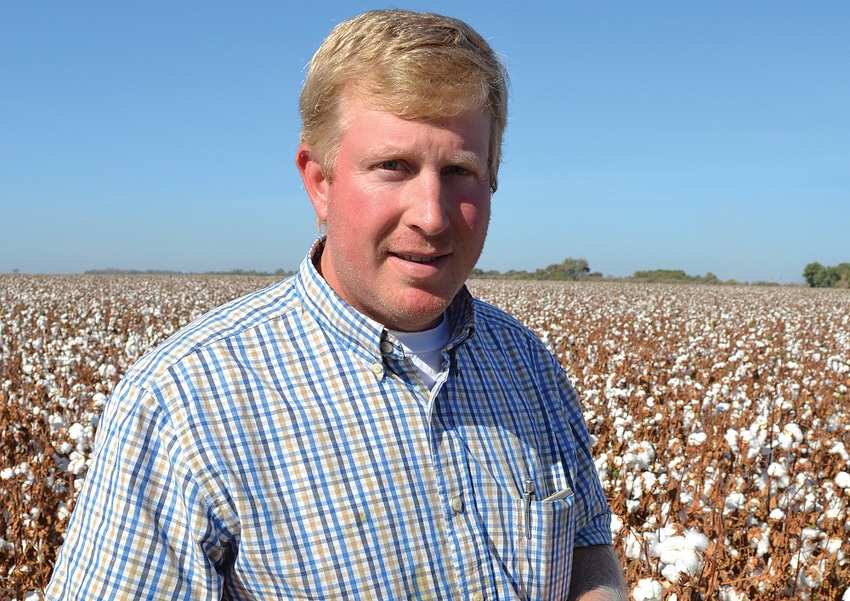January 8, 2013

Chad Crivelli grew his first cotton crop in 1995 as an FFA project. He was the first-ever national fiber crop award winner from California — and he’s been growing cotton ever since.
The opening paragraph of his nomination for this year’s Farm Press/Cotton Foundations High Cotton award for the western states tells the story of the third generation Merced County, Calif., producer.
Matt Whittaker, Helena Chemical Company pest control adviser (PCA) at Merced, Calif., who nominated his former college classmate and good friend, knows Crivelli well. For the past dozen years he has been Crivelli’s PCA.
Chad, who farms 1,800 acres with his father, Bill, was nominated as much for what he does outside the turnrows as what he does inside.
Since 1999, the Crivellis have been part of the San Joaquin Valley Sustainable Cotton Project, which not only works with growers to develop new, reduced cost and low environmental impact cotton-growing techniques, but also to extol the virtues of sustainable farming practices to those who buy SJV cotton.
“Chad has been an advocate and a public face of the cotton-growing community to hundreds of consumers, educators and fashion industry representatives who have toured valley cotton fields in the past decade,” says Marcia Gibbs, director of the sustainable cotton project.
Chad, she says, is part of a “new generation of farmers who are implementing practices that promote good stewardship, protecting the water, air and soil of the region. He is a pioneer in sustainable farming practices and a true champion of our Cleaner Cotton program.”
Pete Goodell, University of California IPM advisor, says, “Chad meets with people during field trips to share the story about sustainable cotton. He is a great spokesperson for urban folks who don’t understand what’s going on in cotton industry. He represents the cotton industry incredibly well, and the High Cotton Award is a well-deserved honor for Chad.”
Big accolades for a quiet, 33-year-old, who wanted only to be a farmer and follow the path laid out by his father and his grandfather.
His grandfather, Henry, moved to the Dos Palos area from Eureka in the 1950s to dairy, and Chad’s father grew the family’s first cotton crop in 1975.
At his parents’ insistence, Chad went to Merced Community College, but farmed at the same time. When time came to transfer to California State University, Fresno, he wanted to stay home and farm full time.
His father laughs, recalling when he and Chad’s mother, Rhonda, drove him to Fresno to make sure he enrolled.
“We watched to make sure he went in the doors,” chuckles Bill.
Chad is glad his parents nudged him. He graduated in 2001 with a degree in plant sciences with an emphasis on agronomy.
“Chad is a very progressive farmer,” says Whittaker. “He stays up-to-date on new technologies, and practices solid IPM strategies and sound fertility programs. He is very innovative and fast to act on opportunities.”
Chad uses UCC heat units guidelines to determine when to plant. GPS guidance systems/yield monitors are on his equipment, and he has installed drip irrigation and water monitoring devices for efficient water use.
While Merced County is in the far north of the U.S. Cotton Belt, at the same latitude as Williamsburg, Va., the county average yield generally ranks a close second to Fresno County. In 2011, Merced’s 1,585-pound average was only 77 pounds behind Fresno. Chad’s 2012 cotton beat the county average by a long shot.
“It was a good year — maybe a little better than last,” he says, estimating 4.25 bales per acre on his 200 acres.
“We were down a bit on cotton acreage. We advance sold saw-ginned Daytona Acala for 97 cents per pound and wanted to plant more, but the price went down and we backed off.”
Next year, he says, if prices increase, he could go up to 700 acres of cotton on his family’s 1,800-acre operation. Their other crops in 2012 included processing tomatoes, alfalfa, corn, melons, vegetables and 40 acres of permanent pomegranates. In the past, he has also grown chili, small grains, organic Pima cotton and hybrid Hazera cotton.
When cotton prices fall, Chad considers himself fortunate to have economic alternatives.
“Twenty years, ago 90 percent of the land around here was cotton after cotton,” says Bill. “We used to be happy with 3-bale, maybe 3-1/2 bale cotton. Now we shoot for 4 bales, and a lot of that is due to the good rotation programs we currently use.”
Chad plants Daytona cotton, an older variety developed by California Cotton Planting Seed Distributors and now marketed by Bayer CropScience. Although it has a reputation for being tough to get out of the ground, he says it can be worth the wait because it is more heat-tolerant than other varieties.
“It seems to have a better fruiting cycle with our weather; we cool down more at night more than other areas.” He’s talking about days of 110 degrees and nights of 82 — ideal for the right cotton variety.
He hill drops four seeds and aims for a plant population of about 58,000 per acre. All his crops are on 40-inch centers. For tomatoes, it’s 80-inch beds.
Chad wants his cotton in by April 10 and out by the end of October. Dos Palos has a tendency to get early fall rains, and growers hurry to get cotton out.
Farming, he says, is a “constant learning curve,” which is a big reason he signed up for the Sustainable Cotton Project.
“Cotton growers can be stuck in their ways,” he says. “We need to look to other people to prove to us there may be greener ways to grow cotton, using fewer pesticides.” The sustainable project “allows us to balance things.”
The Crivellis will treat for insects, but only “as needed.” “We have released beneficials like lace wings, ladybird beetles and minute pirate bugs,” he says.
They plan to always have cotton in their rotation.
“One thing that has helped us stay in cotton is cottonseed prices,” Chad says. “With a 4-bale crop, cottonseed can mean $100 per acre of income.”
He remains committed to the sustainable program and has produced organic crops, but grows annoyed when there are no rewards for a commitment to reduce cotton’s carbon footprint.
Bill says, “We get a little frustrated when we reduce the of use pesticides and do things to improve air quality, then some of the people who come to the farm go back to San Francisco and do and say things that make it difficult for us to farm.”
Nevertheless, Chad is committed to looking for better ways to grow cotton, and has gained the admiration of his neighbors.
Daniel Burns, San Juan Ranch, who won the High Cotton Award several years ago, says, “I’ve known the Crivellis for 30 years; Bill and I went to school together, and our kids grew up together.
“Chad is a hard worker. He’s out in his fields every day, scratching and clawing like the rest of us in farming.”
Burns notes that Chad has been a leader in the sustainable project, “which has benefitted the cotton industry in meeting formidable challenges.
“Chad and the Crivelli family are very deserving of the High Cotton Award. They not only are good farmers, but are community leaders who are well-respected in this area.”
About the Author(s)
You May Also Like






